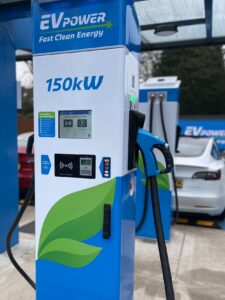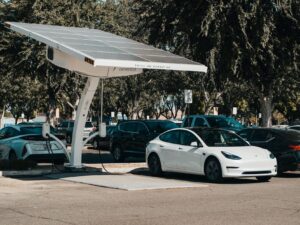Summary
In India, EV sales in FY22 rose over 200% relative to FY21 across segments- 2-wheelers, 3-wheelers, passenger vehicles, and commercial vehicles. As EV sales accelerate, each segment will see EVs gaining share while ICE vehicle sales will peak and decline at different points during the coming decade. This transition will create tremendous opportunities in the EV ecosystem and huge challenges across the ICE sector.
Accelerating sales of EVs
Global sales of e-cars (including plug-in hybrids) rose from 3 mn in 2020 to 6.6 mn in 2021 with China leading with 3.4 mn followed by the EU at 2.3 mn and the USA at 0.5 mn.
In India, sales of electric vehicles (EVs) across segments – two-wheelers (2W), three-wheelers (3W), passenger vehicles (PV), and commercial vehicles (CV) grew from 135k in FY21 to 429k in FY22 with the largest volumes coming from E2Ws and E3Ws as shown in the chart below. Subsidies from the Centre (FAME 2) and states helped bridge the price gap and are expected to continue till price parity is reached. Further, the operating cost of EVs is about 20% of comparable ICE (internal combustion engine) vehicles. This makes a compelling combination and is leading to a surge in demand.
The sales figures are only for E2Ws and E3Ws with speeds over 25 Kmph that need RTO registration. Sales of lower-speed EVs are not captured but are believed to be substantial for 2Ws and 3Ws.
EV Sales in India (Nos)
Source: FADA/VAHAN
Segmentwise trends for EVs in India
Clearly, the trajectory of EV sales is very different for each segment – 2W, 3W, PV, and CV. Each needs to be viewed separately.
Electric Two-Wheelers (E2W)
With Govt subsidies, E2Ws are priced at or sometimes even lower than equivalent ICE 2Ws. Consequently, market demand has shot up. While 231k E2Ws were sold in FY 22, in March 2022 alone the sales were about 50k. In April 2022 sales of E2Ws were maintained at almost 49k in spite of component shortages. Industry sources report that demand is running at over 100k per month and expect to close FY 23 with sales of around 700 to 800K E2Ws. This implies penetration of about 13% of the 6 mn pa domestic scooter market. In FY24, with the expected easing of supply problems and the introduction of several e-mobike models, E2W sales are expected to further grow to about 1.5 to 2 mn – constituting over 10% of the total 2W domestic market.
E2W sales are dominated by new, focused players like Hero Electric, Okinawa, Ampere, Ather, Pur, and Ola Electric who collectively accounted for an 80% share in FY 22. Incumbent 2W leaders like Bajaj and TVS each have a 3 to 4% market share. Hero Moto is planning an entry in July 2022 under the Vida brand. Ola commenced deliveries only in Nov 2021 but, by April 2022, had become the largest seller of E2Ws.
Most E2W players have announced aggressive capacity expansion plans- collectively adding up to 6 mn pa capacity by 2023. The most ambitious plans are from Ola Electric ( 2 mn pa by 2023 and 10 mn pa by 2025), Hero Electric (5 mn pa by 2025), and Ather (1 mn pa by 2023).
With this sales trajectory, and the new E2W capacity being set up, the share of EVs could exceed 20% around FY26 and rise to about 50% by 2030. Sales of ICE 2Ws are likely to peak around FY 26 and steadily decline thereafter.


Electric Three Wheelers (E3Ws)
With Govt incentives narrowing the price gap and attractive operating costs, the shift towards electrics has already occurred. In FY22, E3W sales amounted to 178k in a total 3W market of 390k- a 46% share. As demand for passenger trips and last-mile delivery in urban areas grows, E3Ws will see further sales growth.
The market for E3Ws in India is highly fragmented with no player having over 10% share. The largest- YC Electric- had a 9.6% market share in FY22 followed by Saera Electric at 4.8% and Mahindra Rewa Electric at 4.5%. The leading five firms collectively had just 27% market share. Established 3W players like M&M and Piaggio have made a negligible impact so far with each having under a 3% share. The 3W market leader Bajaj Auto plans to launch an E3W in June 2022. The contest for market leadership is wide open and intense competition is likely in the coming months.
The share of E3Ws is likely to cross 50% in FY22 and move towards 80% by FY 25.
Electric Passenger Vehicles (EPVs)
Sales of EPVs shot up from a low base of about 5k in FY21 to almost 18k in FY22. This surge has been driven primarily by Tata Motors (TaMo) which had a market share of 85% in EPVs followed by MG Motors at 11%. With Central/State subsidies reducing the price gap, and favorable operating costs, TaMo is reporting a spurt in demand. In spite of supply problems, it plans to sell 50k-75k EPVs in FY 23. TaMo intends to invest Rs 15,000 Cr in EPVs and roll out 10 electric models by 2025, spanning multiple styles, ranges, and price points.
The domestic market leader in PVs – Maruti Suzuki with a share of 43% in FY22- plans to launch its first EV model only in 2025. Meanwhile, its Japanese parent Suzuki is investing about Rs 3,000 Cr in EV manufacturing. Hyundai has plans to invest Rs 4,000 Cr and launch 6 EPV models by 2028.
As more players launch EVs and models proliferate, and the price gap with ICE PVs declines, steep growth in sales can be expected around 2025. EPV share is likely to rise beyond 10% by FY 26 and cross 30% by 2030. ICE PV sales are likely to peak around FY 28 followed by a gradual decline in subsequent years.
Electric Commercial Vehicles (ECVs)
ECV sales (at just 2200 units in FY22) are still at a nascent stage in India and are driven by buses. However, small commercial vehicles (SCVs)- used for last-mile delivery of supplies or parcels- is a segment ready for EVs. As in 3Ws, the purchase decision is driven purely by economic considerations. TaMo has announced the launch in September 2022 of the electric version of its Ace, sub-one tonne, SCV. With a range of about 150 km, the Ace EV is targeted at e-commerce firms addressing the growing demand for urban home deliveries. The company has already booked orders for 39,000 units from players like Amazon, Big Basket, Flipkart, and City Link. Switch Mobility (Ashok Leyland), plans to make E SCVs and E buses at a new facility. It is expected that EVs will penetrate over 30% of the SCV market by FY 26.
In medium and heavy CVs, typically used for inter-city, hub and spoke, and long haul applications, there is no visibility yet on the launch of EVs. They need higher energy storage along with fast charging stations located along highways. Electric M&HCVs are still under development. Apart from next-generation batteries, hydrogen fuel cells are being evaluated. Availability of such vehicles and their TCO (Total Cost of Ownership) parity with ICE vehicles is expected towards the end of this decade.


Opportunities in the EV Ecosystem
The expected growth of EVs in India will create enormous business opportunities.
- EV supply ramp-up: As demand for EVs accelerates, several new entrants (eg. Ola and Hero Electric) and focused players (eg TaMo) have announced significant investment plans. The existing leaders in ICE vehicles are belatedly making plans to launch EVs, often with PLI benefits. Huge investments and capacities will be needed to reach India’s EV targets for 2030.
- Charging Infrastructure: This is a critical prerequisite for the mass adoption of EVs. There is a wide spectrum of requirements: fast charging, overnight charging, public facilities, highway stations, private units, and charging solutions for multi-apartment buildings. Several firms are entering this field. Tata Power (TPC) for instance has set up a network of 1000 charging stations across 180 cities and multiple national/state highways -with plans to expand to 10,000 stations. In addition, TPC already has around 10,000 home EV charging points. Oil Marketing Companies too are investing in charging infrastructure in their fuel stations. Eg. Bharat Petroleum plans to set up 7,000 EV fast-charging stations by FY25.


- Battery Swapping: The draft Govt policy encourages battery swapping and a battery as a service (BaaS) business model. These are likely to be attractive for E2Ws, E3Ws, ESCVs, and fleet operations. New ventures in this area are likely once the policy is announced.
- Components: EVs have fewer components than ICE vehicles. The major items e.g. batteries, motors, and electricals/electronics are highly specialized. Most such components are currently being imported. Several new ventures to make these components have been announced, often supported by the PLI scheme. Eg. Suzuki is investing Rs 7,300 Cr in making Li-ion batteries. Lucas TVS is investing about Rs 3,000 Cr in manufacturing motors and Li-ion cells for EVs.
- Global hub: As the domestic EV market develops, India has the potential of emerging as a global supply hub for E2Ws, E3Ws, small EPVs, and ESCVs. TaMo has already stated its intention to develop sub $25,000 EPVs for the global market.
- Race for market leadership: The EV sector is currently supply constrained and has attracted numerous competitors- especially in 2Ws and 3Ws. Several of them assemble imported kits with little attention to engineering or quality. The recent spate of battery fires has highlighted this problem. As more players ramp up and competition intensifies, firms & brands having a reputation for reliability, service, product innovation, and quality will be preferred leading to a shakeout and the emergence of market leaders. The contest in each segment is wide open.
Challenges for the ICE sector
All firms will have to prepare for sales for ICEVs peaking during the next few years and declining thereafter. Existing auto producers will need to define their EV strategy -balancing their existing market presence, ICE assets, and product range- while competing with aggressive new ventures. Component suppliers will have to address the EV market and seek new avenues for their capabilities. Energy companies can reorient their facilities to cater to electricity charging for EVs and later participate in the hydrogen supply chain.
EVs- Accelerating for Takeoff
Each segment of the auto industry in India is following a different trajectory in going electric. In 3Ws, the transition to electrics is already a reality. In other segments, as penetration by EVs accelerates, the point where ICE vehicle sales peak and start declining will occur during the latter half of this decade. This transition will create new business opportunities and fresh challenges across the auto ecosystem. Concurrently, the proliferation of new EV ventures will face a shake-out and consolidation process. EV players who scale up fast, differentiate themselves, and create strong customer relationships will be the winners.


